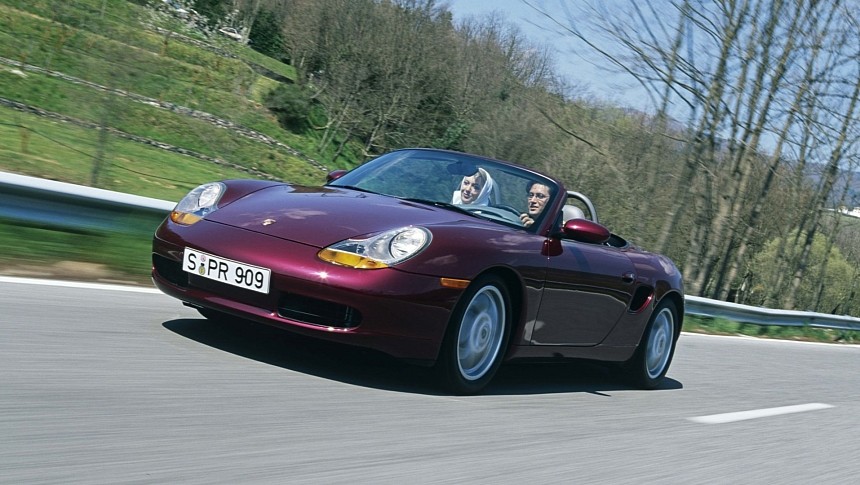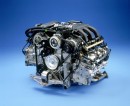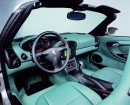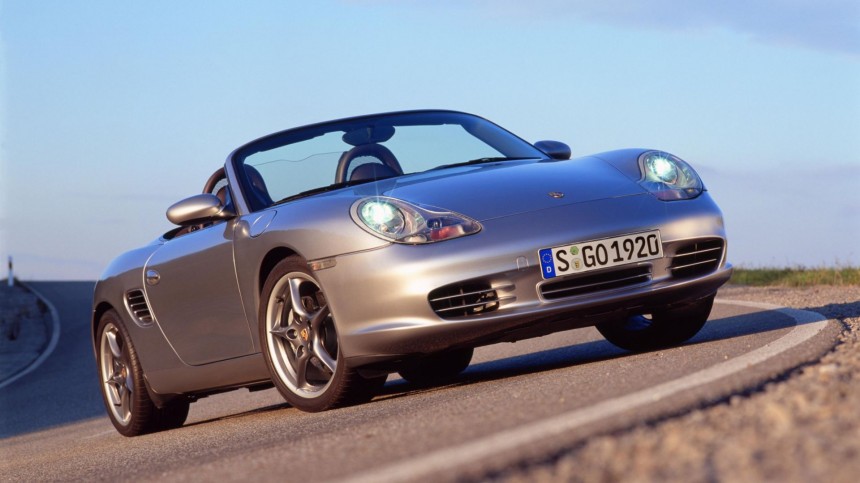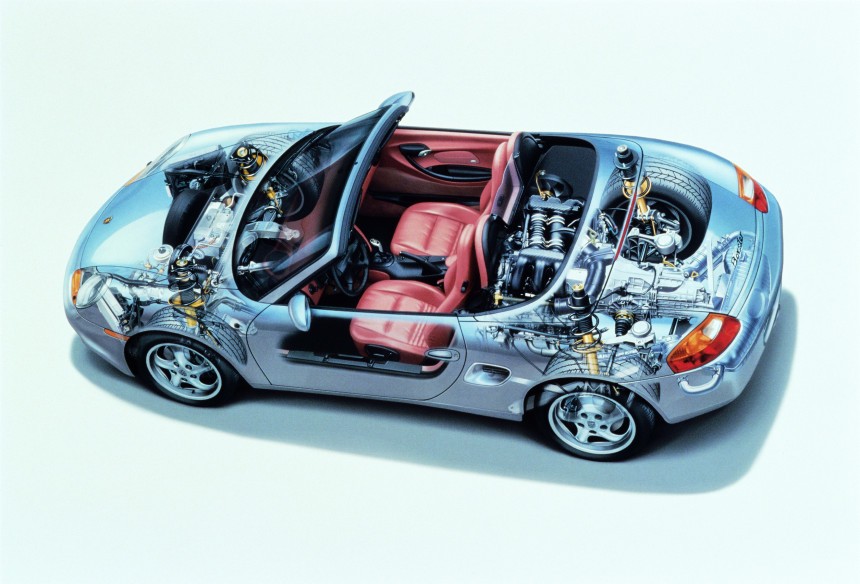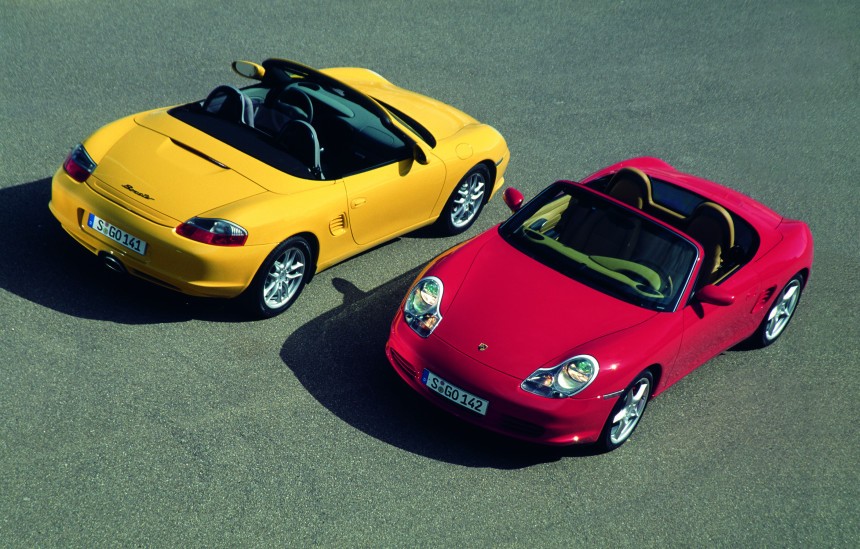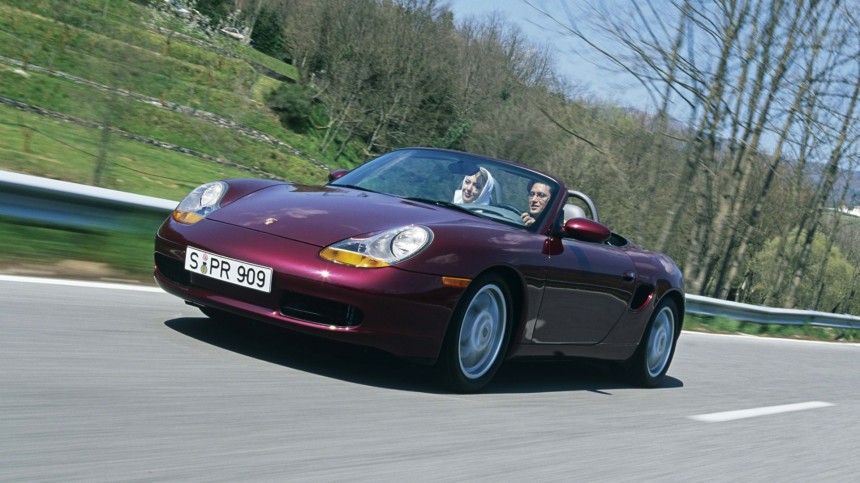About six months ago, I decided to buy a Porsche Boxster. “It’s like, probably the last cheap Porsche,” I mumbled into my beard. Fast forward, and I still don’t have one, but what I do have is an absurd amount of information on the 986 generation (that’s 1997 to 2004) Boxster. So, here it is, in the hopes that someone will be more successful than I in their quest for cheap Porsche ownership.
The Boxster was a massively important car for the brand. At the time of its inception, Porsche was in dire straits. The company fund was running dry, the 911 wasn’t really selling all that well, and the brand desperately needed a way to stay relevant. The Boxster was billed as a cheaper P Car for the masses and, boy, did it work! The car bought Porsche enough time to get the Cayenne off the ground, saving the company in the process, while simultaneously becoming its best-selling model for some years.
• 1997: The Boxster debuts with a 2.5-liter mid-mounted flat-six making 201 horsepower and 181 lb-ft of torque. A five-speed manual or automatic transmission is offered.
• 1998: No major changes
• 1999: You guessed it – no major changes.
• 2000: Base Porsche Boxsters get a bump. Now powered by a larger 2.7-liter engine, the car makes 217 hp and 192 lb-ft of torque. An S version is introduced. Changes for the Boxster S include a 3.2-liter engine with a six-speed manual (or the 5-speed auto) making 250 hp and 225 lb-ft. Upgrades also include 996 911 brakes, 911 wheels, stiffer rear springs, a third radiator, and a dual-tip exhaust instead of the base car’s USB-like exit.
• 2001: A new single-row Intermediate Shaft Bearing (IMS) is introduced – more on this later.
• 2002: Nada
• 2003: This was another large refresh. Power outputs rise to 228 hp and 192 lb-ft of torque for the base, and 258 hp and 229 lb-ft of torque for the S. Creature comforts now include a glovebox and a nicer top, one that’s better insulated and features a glass window. This is a common retrofit and a cheap one for earlier models.
• 2004: No new changes here, save for a very neat special edition. The 550 Spyder 50th Anniversary Edition Boxster wasn’t just a mouthful. It got more power (264 horses) than the S models which it was based on, as well as some very, very cool wheels.
Generally, the earlier dual-row IMS is held to be sturdier, but later 986s are more desirable due to other updates. Either way, a single fact remains: other Porsche people will always ask if this issue, along with a new clutch and rear main seal, has been remedied. If you ask me, the best thing to do is bit the $3,000 or so bullet and do all three in one go- Boxsters with these items taken care of are always worth more money.
On the subject of engines, bore scoring and slipping sleeves can be an issue on these cars, but failure rates are incredibly low. Your best remedy here is a solid pre-purchase inspection from a reputable Porsche shop. However, the car’s air-oil separator is a known failure point and one you may want to have addressed preventatively. Thankfully, the DIY is pretty easy if you’re handy with a wrench, and OEM ones can be bought for under $200.
Other failure points are largely down to the car’s age. A foam insulator in the car’s heater assembly will occasionally fail, blowing foam into your interior. The remedy is a relatively simple DIY, but some shops want quite a lot of money to fix it. Here, the heater assembly can be disassembled from just in front of the wipers and new metal and foam plate installed.
Coolant expansion tanks are known to crack and fail, and the DIY can be simple if you’re a competent mechanic. The tank itself is housed in the Boxster’s rear trunk, and you’ll probably walk out to a wet trunk if this item fails. Also, keep an eye out for overheating.
Tires can be expensive on these cars, as Porsche not only staggered the wheels, but made the rear tires quite large. On base cars, these can measure 255 in width in some cases.
Soft tops with plastic windows are wont to tear and wear faster than upgraded ones- – hence the popular 2003+ top retrofit. Again, the DIY here is straightforward, and nice tops are generally around $1,000 new. Inside, plastics and switches can wear, but replacements are in plentiful supply.
The most important item of note here is that the 986 is OLD. Random items that aren’t listed will fail, and when they do, Porsche parts premiums hit. These cars are cheap up front, especially the base models, but you will pay for it in maintenance. Learn to work on the car yourself (which can be a pain due to limited engine access) and you’ll save a bundle.
Heated seats were never standard on Boxsters, but they are a must if you ask me. Thanks to the sticker held under the hood of all Boxsters, you can look up option codes to see what car has what options. For heated seats specifically, you can also check on the car’s center tunnel, just aft of the window switches.
However, the most important optional extra to be aware of is PSM, or Porsche Stability Management. This is traction control, and if your Boxster will be a four-season car, it is something to consider. A button replaces a blank switch on the left of the radio if you can’t find the options sticker.
Porsche had two seat options for the 986. Hardbacked sports seats are incredibly rare and very distinctive – these bring a premium. Power seat bases with lumbar support and memory function are a rare option as well, but the seats are comfortable enough without.
Now that these cars have aged, their stereos have become problematic with modern infotainment. If you want to swap this stuff around, try and find a car with as basic a radio as possible. A Bose system with nav was offered, but not common.
Colors vary, and more interesting ones like Speed Yellow (very rare) or Arena Red bring a premium. Generally, get the coolest color you can afford but not at the cost of mechanical integrity.
Instead, some websites like Classic.com have made it very easy to track current market averages. Right now, averages are as follows: $15,276 for a manual, base car, $19,324 for a stick S, and $13,514 for a base automatic. As a general rule of thumb, I would expect prices to swing some $3,000 or so depending on the car’s condition, options, and modifications. As always, the best Boxster you can buy is the lowest-mile, nicest example you can find after a thorough pre-purchase inspection by a reputable Porsche shop.
The flax-six makes that iconic Porsche howl on the way up to redline, while also sounding a bit breathy and farm-y at idle. The gearbox is solid, but many owners fit a shorter shifter and some new hardware to firm up what is generally a floppy shifter. The ratios are a bit long, but highway drivers will be grateful.
Thanks to the absurd tire measurements (205 at the front and 255 at the rear for base cars), the Boxster is glued to the road. Noise, vibration, and harshness are noticeable at highway speeds, but these are weekend canyon toys anyway. Ideally, this guide has provided a solid jumping-off point to start your journey to Porsche ownership, and you’ll soon be discovering these things for yourself.
986 model year changes
Let’s kick off with the changes Porsche made over the years, starting with the car’s release in 1997. It’s important to note all Boxsters of this era are mid-engine, rear-wheel drive convertibles.• 1997: The Boxster debuts with a 2.5-liter mid-mounted flat-six making 201 horsepower and 181 lb-ft of torque. A five-speed manual or automatic transmission is offered.
• 1998: No major changes
• 1999: You guessed it – no major changes.
• 2000: Base Porsche Boxsters get a bump. Now powered by a larger 2.7-liter engine, the car makes 217 hp and 192 lb-ft of torque. An S version is introduced. Changes for the Boxster S include a 3.2-liter engine with a six-speed manual (or the 5-speed auto) making 250 hp and 225 lb-ft. Upgrades also include 996 911 brakes, 911 wheels, stiffer rear springs, a third radiator, and a dual-tip exhaust instead of the base car’s USB-like exit.
• 2001: A new single-row Intermediate Shaft Bearing (IMS) is introduced – more on this later.
• 2002: Nada
• 2003: This was another large refresh. Power outputs rise to 228 hp and 192 lb-ft of torque for the base, and 258 hp and 229 lb-ft of torque for the S. Creature comforts now include a glovebox and a nicer top, one that’s better insulated and features a glass window. This is a common retrofit and a cheap one for earlier models.
• 2004: No new changes here, save for a very neat special edition. The 550 Spyder 50th Anniversary Edition Boxster wasn’t just a mouthful. It got more power (264 horses) than the S models which it was based on, as well as some very, very cool wheels.
How reliable is the 986 Porsche Boxster?
This is always the first question on the lips of buyers. This is a 20+ year-old sports car now. There are issues. First, and most obviously, is the infamous IMS bearing. The Intermediate Shaft Bearing is a known failure point on the 986 (and some 987) generation Boxsters. Pre-2006 M96 Porsche six-cylinders will all have a problematic IMS, though everyone on every forum has their own opinions on how bad this issue is. I personally know lifetime Porsche techs that have seen 3-5 failures in their careers. I also know some shops that swear the IMS is basically a hand grenade wedged next to your clutch and that it must be done preventatively.Generally, the earlier dual-row IMS is held to be sturdier, but later 986s are more desirable due to other updates. Either way, a single fact remains: other Porsche people will always ask if this issue, along with a new clutch and rear main seal, has been remedied. If you ask me, the best thing to do is bit the $3,000 or so bullet and do all three in one go- Boxsters with these items taken care of are always worth more money.
On the subject of engines, bore scoring and slipping sleeves can be an issue on these cars, but failure rates are incredibly low. Your best remedy here is a solid pre-purchase inspection from a reputable Porsche shop. However, the car’s air-oil separator is a known failure point and one you may want to have addressed preventatively. Thankfully, the DIY is pretty easy if you’re handy with a wrench, and OEM ones can be bought for under $200.
Coolant expansion tanks are known to crack and fail, and the DIY can be simple if you’re a competent mechanic. The tank itself is housed in the Boxster’s rear trunk, and you’ll probably walk out to a wet trunk if this item fails. Also, keep an eye out for overheating.
Tires can be expensive on these cars, as Porsche not only staggered the wheels, but made the rear tires quite large. On base cars, these can measure 255 in width in some cases.
Soft tops with plastic windows are wont to tear and wear faster than upgraded ones- – hence the popular 2003+ top retrofit. Again, the DIY here is straightforward, and nice tops are generally around $1,000 new. Inside, plastics and switches can wear, but replacements are in plentiful supply.
The most important item of note here is that the 986 is OLD. Random items that aren’t listed will fail, and when they do, Porsche parts premiums hit. These cars are cheap up front, especially the base models, but you will pay for it in maintenance. Learn to work on the car yourself (which can be a pain due to limited engine access) and you’ll save a bundle.
Best options to have for the 986 Boxster
Porsche was just hitting its stride as far as personalization goes with the Boxster. Several accessories were offered, from roof racks to hard tops to tire storage dollies. Some of these are rare items now, like the roof rack and dolly. However, hard tops have held their value better than the cars they fit on. A good one will run you $2,500 to $3,000.Heated seats were never standard on Boxsters, but they are a must if you ask me. Thanks to the sticker held under the hood of all Boxsters, you can look up option codes to see what car has what options. For heated seats specifically, you can also check on the car’s center tunnel, just aft of the window switches.
However, the most important optional extra to be aware of is PSM, or Porsche Stability Management. This is traction control, and if your Boxster will be a four-season car, it is something to consider. A button replaces a blank switch on the left of the radio if you can’t find the options sticker.
Porsche had two seat options for the 986. Hardbacked sports seats are incredibly rare and very distinctive – these bring a premium. Power seat bases with lumbar support and memory function are a rare option as well, but the seats are comfortable enough without.
Now that these cars have aged, their stereos have become problematic with modern infotainment. If you want to swap this stuff around, try and find a car with as basic a radio as possible. A Bose system with nav was offered, but not common.
Colors vary, and more interesting ones like Speed Yellow (very rare) or Arena Red bring a premium. Generally, get the coolest color you can afford but not at the cost of mechanical integrity.
How much is a Porsche Boxster?
The all-important question – how much does all this mid-engine goodness cost? That’s a rather complicated question. Porsche people have… a reputation in the automotive community. Some think their cars are worth quite a lot for one reason or another. Generally, they are good people to buy from at a certain price. However, your Speed Yellow base car is not worth $20,000 with 50,000 miles on it.Instead, some websites like Classic.com have made it very easy to track current market averages. Right now, averages are as follows: $15,276 for a manual, base car, $19,324 for a stick S, and $13,514 for a base automatic. As a general rule of thumb, I would expect prices to swing some $3,000 or so depending on the car’s condition, options, and modifications. As always, the best Boxster you can buy is the lowest-mile, nicest example you can find after a thorough pre-purchase inspection by a reputable Porsche shop.
Is the Porsche Boxster worth it?
So, you’ve gotten roughly 1,500 words in. By now, you hopefully have a place to start when it comes to buying one. But how do they drive? It's a topic deserving of another 1,500 words, but for now, know the Boxster is worth every penny.The flax-six makes that iconic Porsche howl on the way up to redline, while also sounding a bit breathy and farm-y at idle. The gearbox is solid, but many owners fit a shorter shifter and some new hardware to firm up what is generally a floppy shifter. The ratios are a bit long, but highway drivers will be grateful.
Thanks to the absurd tire measurements (205 at the front and 255 at the rear for base cars), the Boxster is glued to the road. Noise, vibration, and harshness are noticeable at highway speeds, but these are weekend canyon toys anyway. Ideally, this guide has provided a solid jumping-off point to start your journey to Porsche ownership, and you’ll soon be discovering these things for yourself.
